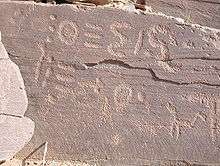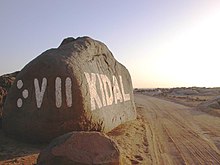Neo-Tifinagh
| Libyco-Berber |
|
|---|---|
 |
|
| Type | |
|
Time period
|
3rd century BC to the 3rd century AD |
|
Parent systems
|
Egyptian hieroglyphs
|
|
Child systems
|
Tifinagh |
| Tifinagh |
|
|---|---|

|
|
| Type | |
| Languages | Tuareg |
|
Time period
|
?? to present |
|
Parent systems
|
Egyptian hieroglyphs
|
|
Child systems
|
Neo-Tifinagh |
| Neo-Tifinagh |
|
|---|---|
 |
|
| Type | |
| Languages | Standard Moroccan Tamazight and other northern Berber languages |
|
Time period
|
1980 to present |
|
Parent systems
|
Egyptian hieroglyphs
|
| Direction | Left-to-right |
| ISO 15924 | Tfng, 120 |
|
Unicode alias
|
Tifinagh |
| U+2D30–U+2D7F | |
Tifinagh (Berber pronunciation: [tifinaɣ]; also written: Tifinaɣ in the Berber Latin alphabet, ⵜⵉⴼⵉⵏⴰⵖ in Neo-Tifinagh, and ⵜⵉⴼⵉⵏⴰⵗ or ⵜⴼⵏⵗ in the traditional Tuareg script) is an abjad used to write the Berber languages.
A modern alphabetical derivate of the traditional script, known as Neo-Tifinagh, was introduced in the 20th century. A slightly modified version of the traditional script, called Tifinagh Ircam, is used in a number of Moroccan elementary schools in teaching the Berber language to children as well as a number of publications.
The word tifinagh is thought to be a Berberized feminine plural cognate of Punic, through the Berber feminine prefix ti- and Latin Punicus; thus tifinagh could possibly mean "the Phoenician (letters)" or "the Punic letters".
Tifinagh is believed to have descended from the ancient Libyan (libyque) or Libyco-Berber script, although its exact evolution is unclear. The latter writing system was widely used in antiquity by speakers of Berber languages throughout Africa and on the Canary Islands. It is attested from the 3rd century BC to the 3rd century AD. The script's origin is uncertain, with some scholars suggesting it is related to the Punic alphabet or the Phoenician alphabet.
There are two known variants: eastern and western. The eastern variant was used in what is now Constantine, the Aures region and Tunisia. It is the best-deciphered variant, due to the discovery of several Numidian bilingual inscriptions in Libyan and Punic (notably at Dougga in Tunisia). 22 letters out of the 24 were deciphered. The western variant was more primitive (Février 1964–1965). It was used along the Mediterranean coast from Kabylie to the Canary Islands. It used 13 supplementary letters.
...
Wikipedia
